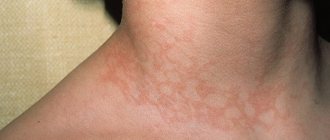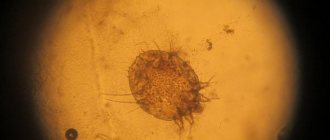Dermatovenerologist
Khasanova
Alina Rashidovna
9 years experience
Make an appointment
Redness of the skin in a certain area of the body, caused by the expansion of the vascular network and increased blood flow into these vessels, is called erythema. Unlike the manifestations of hemorrhage, when pressing on the affected area of the skin, the redness disappears. Skin reactions are caused by various factors - adverse external influences, inflammatory processes, pathological changes. Red spots appearing on the skin may have clear or blurred boundaries, accompanied by swelling, peeling, itching, etc.
Types of pathology
Erythema is classified according to the type of vessels affected:
- active - occurring with a sharp expansion of the lumen of arterial vessels, accompanied by an acute inflammatory process, with bright redness of the skin, increased temperature, swelling and soreness of the skin;
- passive - formed when blood stagnates in the venous vessels during their expansion, accompanied by the appearance of bluish-red or burgundy spots, mainly accompanying inflammation with a chronic course.
Each variety is caused by different causative factors and requires a separate therapeutic approach.
Based on etiology, the following types of erythema are distinguished:
- non-infectious - which are the physiological reaction of the body to external or internal irritants (solar ultraviolet radiation, critically high or low temperature, allergens, etc.);
- infectious - caused by the penetration of infection into the skin capillaries through the surface of the epidermis, from the systemic bloodstream or through the mucous membrane.
Non-infectious manifestations usually do not require special treatment, as they go away on their own after the action of the provoking factor ceases. Infectious reactions are expressed in an inflammatory process that occurs in an acute or chronic form and is accompanied by certain symptoms.
Diagnostics
When making a preliminary diagnosis of “erythema nodosum”, doctors at the Yusupov Hospital take into account the patient’s complaints, medical history, and the results of an objective examination. To confirm or refute it, additional instrumental and laboratory studies are prescribed:
- clinical blood test - to determine signs of the inflammatory process;
- blood test for rheumatoid tests - to identify rheumatoid factor;
- bacterial culture from the nasopharynx - to detect streptococcal infection;
- tuberculin diagnostics – if tuberculosis is suspected;
- stool culture - if there is suspicion of yersiniosis;
- biopsy of nodular formations and subsequent microscopic examination of the biomaterial;
- rhinoscopy and pharyngoscopy - to identify chronic foci of infection;
- chest radiography;
- computed tomography of the chest;
- ultrasound examination of the veins and rheovasography of the lower extremities, allowing to determine their patency and the severity of the inflammatory process;
- consultations with doctors of related specialties - infectious disease specialists, otorhinolaryngologists, pulmonologists, phlebologists, etc.
The diagnostic regimen is selected by highly qualified specialists at the Yusupov Hospital individually for each patient, taking into account the clinical picture of the disease and other important data.
Non-infectious manifestations
In accordance with the causes that caused them, erythema of non-infectious etiology is divided into:
- infrared - provoked by infrared radiation, the power of which was not enough for a full burn, and manifested in the form of a reddish vascular network;
- X-ray – caused by exposure to X-rays or high-frequency electromagnetic waves;
- symptomatic - appearing after contact with an allergenic agent in the form of hyperemic convex spots of irregular shape;
- idiopathic - formed under the influence of heredity as an increase in the diameter of capillaries at the junction with the vascular network, with redness of the palmar surfaces;
- cold - formed when the skin is exposed to low temperatures, manifesting itself in the form of a bluish-reddish rash with local swelling and itching;
- ultraviolet - appearing as a result of exposure to ultraviolet radiation on the skin.
In most cases, when the action of the provoking factor ceases, the redness disappears after some time. In some cases, symptomatic help is required.
Infectious pathologies
Various pathogens can provoke the development of infectious inflammation of the skin - bacteria, fungi, viruses or parasites. This form is characterized by an acute course, which can turn into a chronic form. The patient needs immediate medical attention.
In its acute form, the most common erythema infectiosum in children is caused by parvovirus B19. It is characterized by the sudden onset of the disease, the characteristic signs of which are:
- rapidly rising body temperature;
- muscle pain, headache;
- the appearance of a red rash covering the face and body on the third or fourth day after the onset of the disease;
- gradual increase and closure of spots.
After some time, clinical manifestations gradually fade away until they disappear completely. If left untreated, the process can become chronic. The patient remains able to transmit the infection to healthy people for several days after recovery.
What is fifth disease?
Fifth disease is an infectious disease caused by parvovirus B19. Most often it affects children aged 5 to 15 years. This disease is considered mild because children mostly feel well, even if they develop a rash. The medical name is erythema infectiosum, and the phrase “fifth disease” arose because erythema was fifth on the list of six common childhood diseases accompanied by a rash. Here is a list of these diseases:
- measles
- scarlet fever
- rubella
- Infectious mononucleosis
- erythema infectiosum
- roseola infantile (sudden exanthema)
Fortunately, having recovered from the fifth disease, your child will forever acquire immunity to it.
Nodular pathologists
The causative agent of erythema nodosum is usually streptococcus, and less often - some other infections. It often occurs against the background of tonsillitis, scarlet fever, and tuberculosis. You can recognize it by the following signs:
- rashes of bright red color, with bulges forming in the subcutaneous layer;
- asymmetrically located spots;
- gradual bluing of the spots, then yellowing, similar to the resorption of bruises;
- presence of fever;
- painful sensations and itching in the affected areas of the skin;
- the presence of multiple seals on the legs.
The patient is prescribed a course of antibiotics, antihistamines, as well as external treatment with antiseptics.
Treatment, reviews
The main goal of treatment is to eliminate the identified disease that caused the development of this nonspecific immunoinflammatory syndrome.
To treat the underlying disease of infectious etiology, the use of antibacterial, antifungal and antiviral agents is prescribed.
Primary erythema nodosum requires treatment using drugs from the following groups:
- nonsteroidal anti-inflammatory drugs (Movalis, Nimesulide, Celecoxib, Diclofenac);
- corticosteroids (Prednisolone, Methylprednisolone) – used in the absence of sufficient effectiveness of NSAIDs;
- aminoquinoline drugs (Delagil, Plaquenil) - prescribed to patients with frequently recurrent and protracted forms of the disease;
- antihistamines (Suprastin, Loratadine, Cetirizine).
To quickly regress the symptoms of the disease, extracorporeal methods can also be used - plasmapheresis, hemosorption and laser irradiation of blood.
In addition, local treatment is effective: anti-inflammatory ointments, in particular hormonal ointments, as well as compresses based on dimexide, can be applied to the skin.
Positive results in the treatment of erythema nodosum are also achieved by using physiotherapeutic methods: magnetic and laser therapy, ultraviolet irradiation in erythema doses, phonophoresis with hydrocortisone on the affected areas.
Treatment of erythema nodosum at home can have serious negative consequences, since the drugs used have side effects that can cause significant damage to the patient’s health.
Multiform exudative pathologies
The etiology is still not fully understood. The cause is believed to be an infection present in the body. The disease is usually chronic, with constant relapses. Symptoms of erythema multiforme exudative type are:
- slight increase in temperature;
- pain in muscles and joints;
- rashes with a central papule and clear boundaries of spots, located mainly on the bends of the limbs;
- uneven color of spots;
- symmetrical location of rashes on the body;
- tendency to grow with the formation of “garlands”;
- slight deterioration in general health.
The main difficulty is diagnosis, since the signs partially correspond to a number of other diseases. Before prescribing a course of therapy, differential diagnosis is carried out. Medicines are selected taking into account the age characteristics of the patient.
Pass it on to someone else
The infection is transmitted in the standard way - by airborne droplets or household contact. The infection period is quite long - from 3-4 days to two weeks.
The duration of this disease is 5-10 days. At the same time, there are situations when the rash goes away after a few days, and then returns again after some time. This is due to the toxic effect of the virus on the human body when the second infectious wave develops. The body, in fact, is clogged with toxin from this virus, everything begins to subside, the body slowly removes it. But if the child is exposed to bright sun or undergoes active physical activity, such efforts and influences can trigger a repeated reaction. The toxin is released back into the blood and the rash appears again. Moreover, a repeated rash can also persist for 5-10 days.
Article on the topic
The cheeks were covered. How to determine that a child has an allergy?
Migratory type pathology
Infectious dermatosis in the form of migratory erythema after a tick bite initially looks like a slight redness, which quickly increases in size and becomes ring-shaped with a clear hyperpigmented border. Unpleasant sensations, itching or burning may occur in the affected area. The stain persists for several days, in some patients up to a month. If left untreated, the disease becomes chronic, which is difficult to treat.
The disease is caused by the bacterium Borrelia, which is carried by ticks. The pathogen spreads in the body through the lymphatic and circulatory systems, penetrates various organs and other areas of the skin. The joints, muscles, and nerve tissues are most often affected, and less commonly, the tissues of the heart muscle and the lining of the brain.
Are you experiencing symptoms of erythema?
Only a doctor can accurately diagnose the disease. Don't delay your consultation - call
Causes
Erythema can be both physiological and non-physiological in nature.
In the first option, erythema may occur as a result of various psycho-emotional states or short-term abnormal phenomena. This kind of redness goes away very quickly on its own and is not the cause of certain disorders in the body. If erythema is of non-physiological origin, then it can be considered a separate disease, which is accompanied by prolonged redness of the skin and the presence of an inflammation process. Erythema can have many causes. These are viruses, infections, various diseases of the skin and connective tissues, as well as physiotherapeutic procedures that involve the use of sources of thermal or chemical action. Also, causes of erythema may include poor circulation, allergic reactions, regular rubbing of the skin, exposure to cold or chemicals.
Often reddened areas of the skin are a consequence of Crohn's disease, ulcerative colitis and pregnancy. Erythema can also be caused by medications such as penicillin, hormonal contraceptives (pills), non-steroidal anti-inflammatory drugs, anticonvulsants and sulfa drugs.









